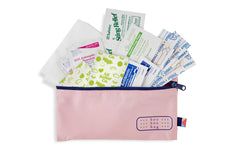by Rachel Perez
Raise your hand if you have a drawer of unidentified cords in your house…yep, us too!
Many of us feel that urge to hold onto an item long after its apparent usefulness has passed. We think that we might need one of those eight power strips one day. And we most definitely should hold onto that stack of laptops in the closet, right?
Getting rid of your stuff comes with some hurdles. However, when you’re downsizing for organization and peace of mind, it’s okay to pull the plug on some items—literally. Getting rid of your old and unneeded items can be straightforward and rewarding with a bit of planning.
With that in mind, here is a minimalist’s guide to discarding those confusing household items! 
The Everyday Items
When you begin your decluttering journey, it’s fine to start small. A crowded closet or haphazard craft room can make excellent jumping points. Take the time and go through all of the stuff that you don’t use every day. One of the key points of minimalism is reducing quantity. So, look for duplicates or unused items, such as:
- Sheets and bedding: A spare set or two is fine, especially if you’re used to guests. However, anything that’s collecting dust has many options. If the fabric is in good condition, or unused, consider donating them to charities. You might also find some buyers on local online marketplaces. As well, old bedding is often accepted by homeless and animal shelters.
If it’s no longer in a condition that someone else would be interested in, there are clothing recycling bins at many local community spots–including gas stations or on school campuses. Pro-tip: Google “textile recycling bin near me” to find one!
-
Old office supplies and equipment: Used printer cartridges, old packing material, and half-used pens once filled my office closet. I brought my unused packing plastics and unused moving boxes to my local shipping stores. I also recycled my old, unused writing supplies with a mail-in recycling program.
-
Art and decorations (with no intent of display): Sometimes, you’ll receive a questionable piece of art as a gift. Or, like me, you were really into meta-physical pop art for a while. Your unused art and decorations are usable by others! Consignment shops may take art pieces, provided they aren’t too gauche. You can also list them on online markets for pickup or sale.
- Unused kitchen gadgets: Why are there so many models of blenders? I had three different blenders at one point. One was still in the box, and another was missing the power cord. Unused kitchen equipment and small appliances have many disposal options. Donation is always a worthy route. Otherwise, resell anything like-new, and recycle the broken bits.
 Cosmetics, Clothes, and Kids’ Clutter
Cosmetics, Clothes, and Kids’ Clutter
Plenty of clutter comes from old clothes that we no longer wear. Plus, there’s always the ever-present drawer of cosmetics and supplies.
Clothes can find a lot of second uses through resales. Online consignment shops provide streamlined options to get decluttered without leaving the home. Don’t forget about like-new shoes. Branded items have great resale value, and even normal shoes and footwear are sought after.
Pro-Tip: Did you know that The RealReal even takes kid’s shoes like Adidas, Jordans and other higher end sneaks that you were super excited to buy and they only wore a handful of times?!
For items in less-than-perfect condition, consider donating to charities. Coats, backpacks, and even shoes are always needed. Look out for back-to-school drives to offload your unused clothes and supplies.
While you’re at it, round up the unused toys from your kids’ rooms. Declutter and downsize in the same instance. Minimize the quantity of your kids’ toys, and instead place the focus on the quality of toys.
Of course, do this with your children! Focus on fun, educational toys like activity desks and bookshelves. Don’t remove all of the fun, but with a more open, specifically-chosen activity selection, your kids will benefit from toys that engage.
Don’t forget to donate those old toys and objects. Make it a charitable family day. Teach your children the importance of helping those in need. Highlight the value of passing on one’s toys, especially the joy of understanding another child’s happiness.
Pro-Tip: If you’re struggling to find a local place to donate, we’ve had a lot of luck with Facebook Marketplace. List groups of similar toys and meet up in a central, safe location to pass off.
 All of Those Devices
All of Those Devices
Where do all of these devices come from? Why do I still have my last four phones? Do they even make DVDs anymore?
These (and more) were questions I asked myself while going through my electronic storage bin. Be it sunk cost fallacy or just plain sentimentality, I struggled with getting rid of electronics and devices. What helped was donating my old phones to the NCADV phone donation service. This, and other charitable organizations, provide phones to those in need.
After that, it wasn’t difficult to minimize my electronic clutter. Anything in working order, like old tablets and even a handheld game system, were all donated. These are completely viable for resale, but I wanted the satisfaction of helping others.
Take a look and consider devices that see minimal use. These include:
- Multiple TVs (keep one, donate the others).
- Obsolete-to-you equipment (no, you don’t need that VCR right now).
- Cords and chargers (you can have too many, and others might need an extra).
- Old, or multiple, video game systems (we have a “one console, one mobile” rule in our home).
Donating electronics is wholesome and rewarding. In today’s digital age, everyone deserves to stay connected with the world.
Not in shape to donate? Pro-Tip: Google “electronics disposal near me” (or recycling) to find a place to safely dispose of or recycle these items.
Final Thoughts
Minimalists know that downsizing doesn’t mean eliminating what they love and enjoy. In fact, minimalism embraces the key facets of life that bring joy: time with friends and family, a love of reading, and even a collection of something super special to you. Everyone deserves those aspects of delight, and decluttering your life (and lifestyle) helps return your focus to that happiness.
Accentuate that joy and donate your unneeded items. Remember, your excess is likely someone else’s needed treasures. And that knowledge is surely one to seed happiness within your family.





Leave a comment